#in-depth
Explore tagged Tumblr posts
Text
Mulder's Brain Disease: an Open-Minded, Analytical Dissection (In-Depth)

Mulder's brain disease, love it or hate it, has to be one of the most unnecessary plot threads of The X-Files. Not only is it wedged into Season 8 haphazardly, but it accidentally stains a new wash of retroactive interpretation into Season 7-- a not altogether successful maneuver, all told.
Most of the canonical evidence provided clashes with itself, many of the details volunteered undermine its collaborative vision, and each piece of action or exposition is either forwarded with the assumption of legitimacy-- and therefore unchallenged-- or immediately discredited in the next scene or scenes.
There are two clear paths and one alternative to explore: Mulder didn't have brain disease (per Season 7's original intent); Mulder did have brain disease but didn't tell Scully (what Agent Doggett is led to believe); and Mulder had brain disease but didn't know it.
Let's begin.
STATEMENT(S) OF (ALLEGED) FACT
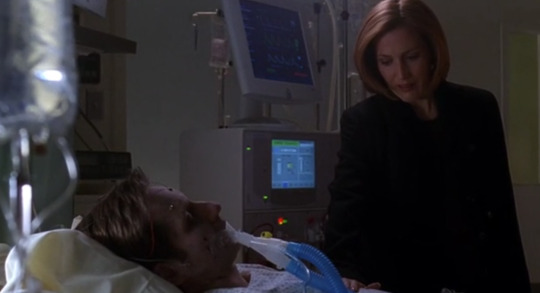
The X-Files is well-known for its... questionable timelines. That becomes exponentially more complicated with Season 8's tightly wound schedule and Scully's pregnancy (which Spotnitz and Carter stuck to rather well-- barring a few logistical hiccups-- post here.)
The brain disease arc inflexibly hinges on a retroactive retelling of Season 7's schedule. One chronological bookend is Amor Fati (stated to have taken place "in the fall"); and the other is the month of May: Mulder takes "four consecutive" road trips to North Carolina, allegedly pops over to Squamash Pennsylvania (twice), and supposedly buys himself a new headrest (read: gravestone)-- all within the span of four weeks. Additionally, we have allegations of a year-long brain disease-- despite all evidence to the contrary-- which places Mulder in a position of secret keeper or liar by omission (which CC has vehemently denied, post here.)
BRAIN DISEASE
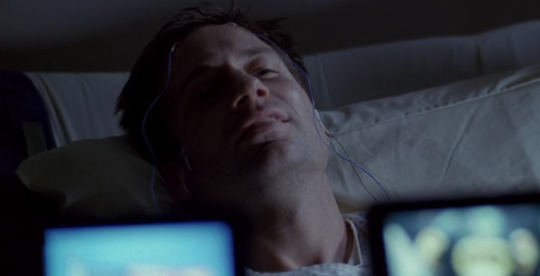
(**Note**: This section's information will be summarized under the "FACTS AND FICTION, THOUGHTS AND THEORIES" subsection.)
Requiem builds on top of the "encephalitic trauma" Mulder experienced in Biogenesis-Amor Fati-- one that, we're told, made him "more alive than he's ever been." So alive, in fact, that his body couldn't support itself and shut down; and so alive, in fact, that CSM cut out a part of Mulder's lobe and Frankensteined it into his own.
The show's mythology set up the alien-human virus as early as Season 3, and built upon that foundation with the characters' subsequent adventures in Fight the Future, The Beginning, and Biogenesis. As a virus, it grafts onto human DNA and changes it-- or in this case, reactivates from junk DNA. As Dr. Anne Simon, a consultant for The X-Files, explains:
Jan. 2001:
"...I work on viruses. Viruses can’t turn into anything. If a virus turns into something, it’s not a virus. I was really horrified. So I read the rest of the script, and I came up with a different science that would only change a few conversations, but it would change the idea of what the virus was. And I had my fingers crossed that he’d go for it. If Chris wanted that virus to turn into something, he would’ve done it whether I wanted it to or not. But he loved the new idea: The virus integrates itself into the DNA of the person. That’s what a lot of viruses do, activate a resonant program in the cell. There’s a program in all our cells, in our DNA that starts with that single egg and turns us into a person. And that’s encoded in our genes, in our genetic makeup.
"The problem is that there’s a huge amount of DNA we don’t have a clue about. There’s a whole lot of DNA that we call junk DNA. We don’t have a clue what this junk DNA is doing. My idea was the virus activates a resonant program in the junk DNA, and that the junk DNA is actually there to turn a cell into the horrible creature, which means that we are the aliens."
Point taken. Multiple (questionable) vaccine inoculations and infections aside, humans in The X-Files world have latent alien DNA. The ancient artifact Mulder handled in Biogenesis activated his; and, unable to bear up under that extremis, his body was reduced to catatonia and shut down. Though there are quite a few problems with that specific chain of events (most of which I discuss in an alien virus post here), the logic could, theoretically, hold up.
ENCEPHALITIC TRAUMA AND REWRITES
In Amor Fati, Mulder was so far gone that he'd disconnected from reality (although his "inner" world was still influenced by outward events.) How, then, was Mulder brought back from the land of fantasy? Metaphorically, it was through Scully's belief and love and courage; practically, it was because of the (successful) medical procedure he underwent during his captivity (post here):
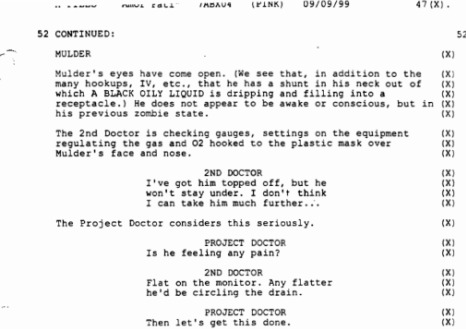

RULING OUT: TREPANATION AND BRAIN EDEMA
Two possible causes for Mulder's later complications need to be explored before we move on.
Firstly, as with a great deal of other components on the show, trepanation is not as simple as the writers propose:
World History.org, here:
"Trephination (also known as trepanning or burr holing) is a surgical intervention where a hole is drilled, incised or scraped into the skull using simple surgical tools. In drilling into the skull and removing a piece of the bone, the dura mater is exposed without damage to the underlying blood-vessels, meninges and brain.
According to Academic Press's 'Osteoarcheology': "A neurosurgeon can perform the procedure safely, although it comes with severe repercussions such as direct or indirect perioperative complications, which include increased damage to the brain, infection, blood loss, hemorrhage, and potentially death due to the trauma as the skull's protective covering is compromised."
Here, its perils are hand-waved away with "advanced alien science"; but to potentially complicate Amor Fati's explanation, the purpose of Mulder's surgery was to slice out an activated portion of his brain and transfer it to CSM's:
Penn Medicine, here:
"A temporal lobectomy, or temporal lobe resection, is a neurosurgical procedure that removes the front part of the temporal lobe of the brain to treat drug-resistant epilepsy. Each person has two temporal lobes, located beneath the skull on the side of the head in the temple region. The temporal lobes play important roles in memory, emotional responses, language, and sensory memory and processing of sounds, visions, and smells."
While it's possible that Mulder's and CSM's declines could have been kick-started by this procedure, that's not the route canon follows. Spender's deterioration is tied to "cerebral inflammation", which in turn is tied to Mulder's pre-surgery encephalitic distress-- in short, pre-trepanation trauma.
Secondly, the script also details a medical procedure that is most often used to relieve and treat brain edema (brain swelling)--
NHS, here:
"Ventriculostomy: In this procedure, a surgeon cuts a small hole in the skull and inserts a plastic drain tube. Cerebrospinal fluid is drained from inside the brain, helping to relieve the pressure.
Surgery: Surgery may have one or more of these goals:
A. Removing part of the skull to relieve intracranial pressure; this procedure is called decompressive craniectomy.
B. Removing or repairing the source of the swelling, such as repairing a damaged artery or vein or removing a growth."
Brain edema-- depending on the extent and duration of the trauma-- usually inflicts various degrees of harm. And while that could be promising when discussing Mulder's brain disease, Scully would have seen evidence of edema-ridden damage on his CT and MRI scans during his convalescence. Further, brain edema is not a form of brain disease, rather an offshoot effect of that condition-- therefore, not the cause of his (alleged) impending death.
AUTHORIAL INTENT AND REWRITES
Inverse to Mulder's reawakening and restored health is CSM's 30 touch-and-go hours and grim, post-operation prognosis:


His doctor's hints about a second surgical intervention are particularly intriguing. When CSM reappears in Closure, Scully notes his odd pallor-- "You're sick"-- which he doesn't deny-- "I had an operation." We are to assume he is referencing the brain surgery in Amor Fati-- he is-- but I would like to posit Spender could be referencing a possible second procedure (an off-screen attempt to mitigate his ailing health.) By En Ami, CSM's fate is sealed, and he openly admits his mortality in order to ignite Scully's trust (post here): "Cerebral inflammation-- a consequence of brain surgery I had in the fall. The doctors give me just a few months." His arc comes to a close in Requiem (unless you push canon into Season 9 and beyond) where we see the rapid toll of his deterioration.
Recovery from "advanced alien science", then, is aided by regular, everyday human physiology: age, health, medical history, and comorbid influences. Spender's age, smoking status, and former cancer diagnosis all combine against him-- his hubris for power led him willingly to death.
By contrast, Mulder's experience wasn't mentioned again until Requiem when he and the Bellefleur residents-- who'd previously suffered encephalitic trauma-- were called to the ship and abducted. There was no idea, hint, or reference sown about his deteriorating health: not a sign, not a symptom. Yet, mere months later, the tale is retold in Within: we learn, allegedly, that not only did Mulder have brain disease (and not only did Scully not know) but he'd also suffered through it for a year.
Frank Spotnitz admitted, after the close of Season 8, that the brain disease (and the IVF arc) was a last-minute creation he and Chris Carter decided on after their plans for a second movie set post-Requiem fell through:
April 2001:
"In the absence of pre-existing context for season 8’s dramatic surprises, the writers relied instead on flashbacks tailored to fit this year’s narrative. “Had I known there would be a season 8, I would have preferred to salt in all of the clues about these flashback episodes last season,” says Spotnitz of how he dealt retroactively with fitting in Mulder’s illness and Scully’s [IVF]. “But there really is no way to unravel these mysteries in my mind, and make use of David in the time that he was available to us, without having some flashback episodes.”"
Setting aside the complete lack of evidence that would “prove” Mulder was suffering from a degenerative brain disease, silently, for a year (without telling Scully), we’re left with a few bare-bone facts:
Season 7 was not written with the brain disease in mind.
Mulder's "encephalitic trauma" in Requiem was shared by the other Bellefleur residents, who were not (that we know) dying.
CSM declared that he was dying from "cerebral inflammation."
CSM's downturn post-Amor Fati was recorded at key moments through Season 7, with scrutable markers of decline and clear indicators of psychological shifts and changes influenced by his impending death.
In Within, we’re led to believe Mulder was suffering from year-long degenerative damage due to the surgery he and CSM underwent in the fall of 1999. Not only do his actions (or non-actions) in canon contradict this thesis, but Within-The Gift's timeline contradicts it, as well.
Deadalive-Three Words Mulder never confirmed he was diagnosed with-- or knew he was suffering from-- brain disease.
What, then, is "cerebral inflammation"; and how can we work in the brain disease as more than a creative (though flawed) hypothetical?
THE FIRST ROUND OF INFECTION

Encephalitis (“cerebral inflammation”) is pretty straight forward: you either have it and notice, or you have it and don’t.
There are two main types of "cerebral inflammation"--
NIH, here:
Inflammation in the brain and spinal cord can be caused by infections such as viruses. Encephalitis can also be autoimmune when antibodies can attack brain cells.....
NIH, here:
"Because people may have subtle symptoms of encephalitis, many cases may go undiagnosed. Several thousand cases are reported each year, but many more may occur since the symptoms may be mild at onset in some people."
Encephalitis hits fast and hard, disappearing within two weeks (Better Health, here) of its inception. Mild instances can pass through the body undetected; but severe or life-threatening cases are unequivocally transparent:
NIH, here,
"Once the acute illness, which normally lasts for 1 to 2 weeks, is under control, comprehensive rehabilitation should include cognitive rehabilitation and physical, speech, and occupational therapy if brain function is severely affected."
Mount Sinai.org, here,
"Those with a severe case of encephalitis may develop:
High fever
Severe headache
Stiff neck and back
Photophobia (sensitivity to bright light)
Sonophobia (sensitivity to sound)
Vomiting
Drowsiness and confusion
Seizures
Behavioral changes
Muscle weakness
Partial paralysis
Loss of consciousness
"Because encephalitis can on rare occasions be dangerous, it needs to be diagnosed and treated promptly....
"Many people exposed to encephalitis-causing viruses have no symptoms. Others may experience a mild transient illness, but do not develop full-blown encephalitis. People with mild encephalitis generally recover spontaneously over a period of several weeks.
"Severe cases of encephalitis can, however, have devastating effects, including:
Swelling of the brain caused by excess fluid (cerebral edema)
Bleeding within the brain (intracerebral hemorrhage)
Nerve damage (neuropathy)
"Encephalitis is a relatively rare disease. People at highest risk for encephalitis, and its complications include the very young, the very old, and people with weakened immune systems."
NIH, here:
"Because the disease can occur suddenly and progress rapidly, anyone who is suspected of having encephalitis should immediately contact a doctor or go to the hospital.
"...In more serious cases, the disease can cause hearing and/or speech loss, blindness, permanent brain and nerve damage, behavioral changes, cognitive disabilities, lack of muscle control, seizures, memory loss, or death. People with serious cases of encephalitis may need long-term therapy, medication, and supportive care."
Lastly, the risks for serious complications arise with the usual physiological predispositions and environmental factors:
Mayo Clinic, here:
"Anyone can develop encephalitis. Factors that may increase the risk include:
Age. Some types of encephalitis are more common or more serious in certain age groups. In general, young children and older adults are at greater risk of most types of viral encephalitis. Similarly, some forms of autoimmune encephalitis are more common in children and young adults, whereas others are more common in older adults.
Weakened immune system. People who have HIV/AIDS, take immune-suppressing medicines or have another condition causing a weakened immune system are at increased risk of encephalitis.
Geographical regions. Mosquito- or tick-borne viruses are common in particular geographical regions.
Season of the year. Mosquito- and tick-borne diseases tend to be more common in summer in many areas of the United States.
Autoimmune disease. People who already have an autoimmune condition may be more prone to develop autoimmune encephalitis.
Smoking. Smoking increases the chances of developing lung cancer, which in turn increases the risk of developing paraneoplastic syndromes including encephalitis."
In Biogenesis, we are told the alien virus in Mulder's DNA is activated when he touches an ancient artifact; but it's debatable if that incident lines up with viral (infection via an outside invader) or autoimmune (mistaken antibodies attacking its host) encephalitis. Regardless, that question is secondary to the main hypothetical: if encephalitis ("cerebral inflammation") has a short shelf life, what was killing CSM (and Mulder?)
REINFECTION: AUTOIMMUNE ENCEPHALITIS
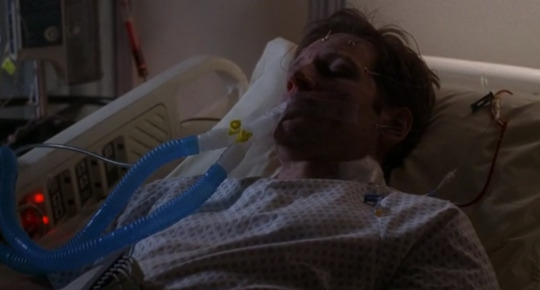
The problem begins with CSM's (and Mulder's purported) year-long deterioration. "Cerebral inflammation", as explained above, does not drag its feet when swooping in for the kill. And more broadly, how is Mulder able to be reinfected with a disease which old Spender sliced and diced from his head? Better Health.gov's description (here) fits what the writers were going for, I believe: "There is evidence to suggest that some cases of viral encephalitis are caused by dormant viral infection... becoming active again." This plays well with Mulder's initial infection (Biogenesis), as well as CSM's lengthy "cerebral inflammation" and Mulder's (alleged) inflammatory reemergence.
However: recurrence is a symptom of autoimmune encephalitis, not viral encephalitis--
NIH, here:
"Although rare, there have been cases of post-infectious autoimmune encephalitis (where it is triggered by an initial response to an infectious agent)."
Autoimmune encephalitis: a review of diagnosis and treatment, here:
"Viral infections are known triggers for AIE. It is believed that virus-mediated brain tissue damage may lead to antigen exposure that triggers the development of anti-neuronal antibodies."
Another checkbox that can be ticked off: AIE might take longer to diagnose because of the difficulty pinpointing symptoms--
NIH, here:
"Diagnosing autoimmune encephalitis can be difficult as the average onset of symptoms to diagnosis often takes a few weeks to 3 months. ...To diagnose autoimmune encephalitis, we need multiple tools to aid in the diagnosis, although clinical judgment is the key to making decisions. They will include a constellation of neuropsychiatric symptoms, lab studies, neuroimaging, and electroencephalogram."
Slowly-degenerative AIE cases (though infrequent) do exist--
Autoimmune encephalitis: a review of diagnosis and treatment, here:
"By way of generalisation, autoantibody-mediated disorders often present rapidly, over a few days to weeks. However, we have observed more chronic courses, of between 1 and 5 years, particularly in leucine-rich glioma-inactivated protein 1 (LGI1)-antibody, contact-associated protein 2 (CASPR2)-antibody and immunoglobulin-like cell-adhesion molecule 5 (IgLON5)-antibody syndromes. These findings mean that time to disease nadir is often outside of the 3-month duration which appears in diagnostic guidelines."
Nevertheless, atypical cases are often put through rigorous testing to rule out other degenerative autoimmune diseases due to the severity of their symptoms: mood changes, mental confusion, muscle tremors, seizures (focal rather than generalized), pain, psychiatric symptoms, and (more often than not) tumors.
Autoimmune encephalitis: a review of diagnosis and treatment, here:
"Seizures occur in most autoimmune encephalitis syndromes and are a common factor that triggers neurological attention. The types and frequencies of seizure vary between autoantibody-mediated diseases and may help pinpoint the individual autoantibody. …These patients, typically men in their fifth to eighth decades, have very frequent focal events with multiple semiologies and only rare generalised seizures....
"In addition to treatment of the underlying immunological process, it is often necessary to consider management of seizures, movement disorders, behaviour, pain, sleep and autonomic disturbance, and mood disorders. We do not discuss this substantial topic comprehensively here but rather we focus on special considerations relevant to the two most common forms of autoimmune encephalitis: NMDAR-antibody and LGI1-antibody encephalitis."
It is possible, however, that the extent of the damage Mulder received during his surgery might have been overlooked-- fertile ground for the next trauma-induced biological onslaught:
NIH, here:
"Because lesions can sometimes be clinically asymptomatic, a systematic neuroimaging work-up should be performed.... Cerebral computed tomography scans [CT scans] performed at admission show abnormalities only in 30% of patients, essentially supratentorial readily visible diffuse or large focal hypodensities of the cerebral white matter. MRI of the brain should therefore be systematically performed when post-infectious encephalitis is suspected."
But the basic premise (and same problem) of 'traditional' encephalitis remains. AIE, though possibly reoccurring, does more harm in the short term than the long run: its most powerful weapon is either immediate death or a damaging domino effect--
NHS UK, here:
"Encephalitis can damage the brain and cause long-term problems including:
memory loss (amnesia)
personality and behavioural changes
speech and language problems (aphasia)
swallowing problems (dysphagia)
repeated seizures or fits – known as epilepsy
emotional and psychological problems, such as anxiety, clinical depression and mood swings
problems with attention, concentrating, planning and problem solving
problems with balance, co-ordination and movement
persistent tiredness"
It's not a leap, then, to suppose that--
CSM's health immediately crumbled apart because of his age, health, and smoker status.
Whereas Mulder's health-- if he was affected-- was bolstered up by youth and other factors. However: that does not rule out a potential sleeper agent lurking in his brain, waiting for the next traumatic incident to reactivate, AIE-style. (We'll get to that.)
FACT AND FICTION, THOUGHTS AND THEORIES

The facts, as we know them:
Encephalitis, no matter its form, is not a slow-burn, long-term killer. Yet, the fallout from its destruction can create a domino effect that could, potentially, be lethal.
Regardless of the original diagnosis, CSM and (allegedly) Mulder suffered from autoimmune encephalitis after Amor Fati.
While mild cases can be undetectable, severe or life-threatening encephalitis can't be masked and must be treated promptly.
CSM is doubly or triply immunocompromised-- per his age, past cancer, and on-going smoking habit-- and was promptly affected.
Mulder and the Bellefleur residents were abducted and transformed due to past "encephalitic trauma", not current, prevalent brain disease.
Most importantly: if Mulder and CSM had been dying over a year's time, there would have been conspicuous physical evidence-- evidence which Scully would have detected (as she did in Closure.)
Irrespective of these facts, let's play around with a few hypotheticals.
If Mulder and CSM had been dying contemporaneously, then they would have to be deteriorating from the ripple effects of at least one of three factors:
Extensive brain damage-- which would have become immediately apparent once they woke.
Accumulative comorbidities set in motion via brain damage-- which Spender did, and Mulder did not, have.
Reactivated effects caused by another traumatic incident-- which Mulder could have had (and did) in Season 7.
That last point is a particularly intriguing theory. Mulder would have been suffering profusely had his disease run concurrently with CSM's-- but what if it didn't? What if Mulder's brain disease was a recent diagnosis-- one he'd received before his abduction? If so:
His reticence from Scully would be short-lived and easily explained by Mulder still processing the news.
His sudden rash of trips to his mother's and sister's graves could be influenced by anxiety over an impending medical report or in reaction to an inflexible diagnosis.
His headstone purchase could be explained as a rash, last-minute gesture of acceptance (or could have been faked by his nemeses, which we shall get to.)
Yet, and this cannot be stressed enough: even if Mulder had a recurrence of encephalitis, it alone would not be enough to kill him, just like it alone would not be enough to kill CSM.
To get to the bottom of any and all possibilities, we need to map out a simple, logical, cut-and-dried timeline.
So, let's do it.
CANONICAL (AND RETROACTIVE) TIMELINE
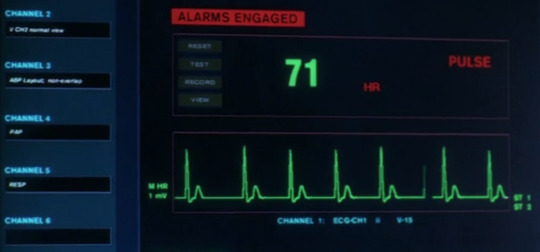
(**Note**: If you don't care to read the discovery process, skip to PUTTING IT ALL TOGETHER.)
To chart a course through the brain disease's cluttered "shoulda, woulda, coulda"s, two options present themselves: episodic air dates, or in-canon date markers.
Here we run into the first problem: neither touchstone works unmitigatedly: either in-canon dates reorder key episodes (perhaps the props department worked off the script rather than day-of filming?) or air dates don't graph cleanly onto defined in-canon perimeters and events. What we'll have to do: nail down the definitives, and work back (loosely) from there.
xfilestimeline.net provides an exquisite guide to (most of) The X-Files's chronological order, which I will be referencing below (direct quotes in italics.)
AMOR FATI
Amor Fati takes place "in the fall" according to Within. The air date (November 14) and in-canon estimate (October 7-14) both roughly group into that space. Mulder is wearing his "victory cap" to come find Scully; but it's hard to know for certain that the hallway scene takes place shortly after the last week of September (which, according to xfilestimeline.net, was the first Yankees victory of the season) or if he simply wore it to cover his bandages and bantered around the obvious.
Either/or is viewer's choice.
SIGNS AND WONDERS
Signs and Wonders's air date (January 23) outruns a "medical report" (January 17-19) by just a few days.
EN AMI
En Ami takes place (comparative to any month afterward) "last spring." Since there is no internal date provided, it either falls on March 19 (its air date) or sometime after February 20 (X-Cops's in-canon date) and before April 14 - May 1/May 8-12 (Brand X - Chimera's in-canon dates.)
Again, viewer's choice.
SEIN UND ZEIT
Sein und Zeit airs on February 6th; but its date is "confirmed" by a TV broadcast of State of the Union Address (January 27 - February 1.)
BRAND X
Brand X's air date (April 16) coincides with its in-canon, two-week recovery estimate (April 14 - May 1.)
CHIMERA
Chimera debuts a full month prior (April 2) to in-canon configurings (May 8-12: Date confirmed at outset ((2 weeks after 4/23)).)
Chimera marks the first overlap between Season 7 and Season 8: Mulder (allegedly) visited Squamash, Pennsylvania on May 6 -7, a day before he and Scully were assigned to a stakeout (May 8.) It's not stated how long Mulder and Scully were on duty before he was again reassigned; but it stretches believability (what else is new?)
ALL THINGS
all things has no fixed internal date, though it's air date (April 9) takes place a full month before the estimated in-canon dates (May 13-15.)
FIGHT CLUB
Fight Club's airing was May 7; but its own internal date (June 17-19) so incontrovertibly contradicts Requiem's abduction timeline that it can be confidently swapped out for May 17-19.
This episode is pivotal to quite a few brain disease theories.
JE SOUHAITE
Je Souhaite air date (May 14) is hastily surpassed by its estimated internal date (May 22-24.)
This episode is vital to understanding the brain disease arc-- more accurately, to understanding Mulder's mind frame when given three wishes.
REQUIEM
Requiem is key to the entire framing of the brain disease arc:
Either Mulder is abducted on May the 21st (Requiem's air date), which shreds through Agent Doggett's May timeline (which will be discussed below);
Or Mulder is abducted on May 31st (the day before Within), which tears fewer rips in Agent Doggett's theory.
Pulling from my "Laying Waste to The Gift (with Its Own Canon)" meta (post here):
A. ...Doggett refers to Mulder's trips as "Four consecutive weekends in May"-- distanced language that (one can infer) means the month is over. (If he and Scully were still in May, Doggett would have more naturally stated "each weekend this month" or "the past four weekends.")
B. Spotnitz has since confirmed Within takes place the day after Scully's reveal in the hospital ("Season eight begins the morning after season seven." Interview here.)
C. Therefore, it's safest to assume Within takes place in June (either June 1st or June 2nd), pushing Mulder's abduction date to May 31st.
WITHIN
Within begins the complete disregard for air dates-- and rightfully so, given the strict guidelines of Scully's pregnancy (post here.)
See Requiem above: takes place June 1st.
PER MANUM
Per Manum takes place mid-September (Scully's baby is fourteen weeks old. Given that she announced her pregnancy to Skinner at the very end of May, it seems likely that she conceived in mid-May, which would give a mid September date for this episode.)
THE GIFT
The Gift is broken into three trips: (allegedly) Mulder, May 6 A.M. - 7 A.M.; (allegedly) Mulder, May 24; and Doggett, late September. (No internal dates provided. It is said to be roughly a "year" since Mulder visited Squamash, but given the events of Episode 8x14: This is Not Happening, it's more like under half a year. Doggett confirms that Mulder was abducted in May. He went to Squamash, PA on May 6-7, and returned there on the 24th. Doggett also reveals that Mulder falsified case reports, which explains how the dates might be off at the end of Season 7.)
This episode is, quite frankly, a catastrophe. I broke down the timeline and its inconsistencies in a previous post, here-- suffice it to say, it discredits its own claims in its own episode. But, we will be returning to this... gem later on.
PUTTING IT ALL TOGETHER
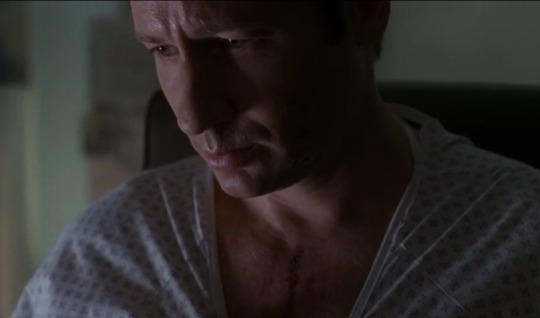
Now that we have a framework for both seasons, we can begin to slot the pieces side by side.
"In the fall", Amor Fati: Mulder and CSM both undergo brain surgery. Mulder fully recovers (or does he?) while CSM deteriorates slowly over the course of a year.
May 6-7, The Gift: Mulder burns up one of his consecutive weekends by (allegedly) taking a trip to Squamash, Pennsylvania on May 6-7.
May 7: Mulder takes his first 370 mile trip (10 hours total) from D.C. to North Carolina and back. He will (allegedly) make three more consecutive weekend drives until his abduction in Requiem.
April 14 - May 1, Brand X: Mulder is hospitalized some length of time during his two weeks of recovery. Neither Scully nor the medical staff notice any medical abnormalities (i.e. odd or troubling physical responses, readouts, or charts) despite heavily monitoring his health.
May 8, Chimera: Mulder has a case ready for he and Scully to investigate (one that likely required the weekend to research-- more on that later.)
May 13-15, all things: Mulder burns up another consecutive weekend on a trip to England.
May 17-19, Fight Club: Mulder takes some heavy hits.
May 22-24, Je Souhaite: Mulder doesn't consider asking the genie-- not once-- to heal his brain disease.
May 31, Requiem: Mulder is abducted due to his "encephalitic trauma", courtesy of Biogenesis's ancient artifact.
June 1, Within: The Alien Bounty Hunter parades around Mulder's life, stealing his (and Scully's) computer.
June 2, Within: Doggett obtains rental car receipts, VISA card purchases, and year-long medical records, thereby coming to the conclusion that Mulder took four consecutive weekend drives (nearly 400 miles, over 10 hours) from D.C. to North Carolina. Doggett and his team do not find Mulder's gun taped under the apartment sink.
Late September, The Gift: Doggett finds a case from last May he and his team had missed. He also finds a bloody gun taped under Mulder's sink that he and his team had missed. He also finds an incriminating report that has Mulder and Scully's name on it that he and his team had missed. He does not check the dates against "Mulder's May Pilgrimages", nor does he corroborate the signatures and evidence with Scully.
Chronological order locked and loaded.
DEBUNKING AGENT DOGGETT'S (ESTIMATED) ITINERARY

Now, let's break down the evidence Doggett "unearths."
SUPPORTING EVIDENCE
In Within, Agent Doggett rests Mulder's brain disease on three rational (and one discredited) facts:
Mulder's surgery "in the fall" (Amor Fati)-- one Mulder did not, apparently, recover from. Doggett and his team discover "evidence" indicating a year-long decline which the files predecessor had kept secret from his medical doctor-partner.
Mulder's "four consecutive weekends" drives to North Carolina ("Same mileage each trip: 370 miles, 375 miles"), which means he either kept them hidden from Scully or she lied to Doggett when questioned.
Mulder's sudden, erratic purchases in May: flowers and a personally-inscribed headstone on the same VISA card.
Mulder's and Scully's missing computers and files (later proven to be the Alien Bounty Hunter's machinations.)
In The Gift, Agent Doggett discovers further "proof" to support his supposition:
Mulder (allegedly) took a trip to Squamash, Pennsylvania to investigate a case on May 6 (Saturday.)
Mulder (allegedly) returned to be healed by the Squamash creature on May 7.
Mulder (allegedly) turned down the opportunity to be healed in order to mercy kill the Creature.
Mulder (allegedly) hid his bloody "murder weapon" (an ankle gun) under his kitchen sink.
Mulder (allegedly) had Scully sign off on his closed report, with or without fully informing her.
Mulder (allegedly) placed his and Scully's careers in danger because of this falsified report... conveniently (post here.)
DESTRUCTIVE CONTRADICTIONS

Problem #1: Doggett Needs Four Weekends
As we've explored, ad nauseam: the car rental receipts Doggett finds in Mulder's desk plainly communicate four weekend trips in May.
Mulder burns up the first weekend of May on the Squamash trips: he arrives in Pennsylvania on the morning of May the 6th (Saturday) and doesn't leave until the early hours of May the 7th (Sunday.) He is then (allegedly) supposed to drive a 10 hour round trip-- without sleep, while (allegedly) suffering the painful effects of deteriorating "brain disease"-- and be back by Sunday night to prep for an X-Files stakeout on Monday. Both trips cannot coincide with each other, which means one-- or both-- have to go.
Mulder burns up a second weekend on his trip to England: he begins preparing to leave on a Saturday (estimated May 13) and arrives back a day or two later (estimated May 15.)
Mulder might burn up a third weekend recovering from Fight Club: the extent of his injuries would probably inhibit his ability to drive safely-- not to mention the possibility of a compounding, painful "brain disease."
Discounting The Gift (which is rife with inconsistencies and contradictions), two of the four necessary weekends were spent elsewhere.
In fact, the only weekend Doggett can rely on (per his own timeline) is the one following Je Souhaite-- three days before Mulder's abduction. (That weekend will be instrumental later.)
Problem #2: Doggett's "Evidence" Doesn't Match His Timeline
Mulder's VISA card made a lot of purchases over the course of May, some of them reasonable (flowers for his loved ones' graves) and some of them questionable (a headstone and rental cars.)
The VISA card's legitimacy was authenticated by the rental receipts on Mulder's desk-- but those rental dates don't match with Mulder's recorded movements (either by air date or canonical rewrite.) Discounting the Gift, at least two out of four weekends were spent in D.C. or England, not on the road back-and-forth from North Carolina.
Doggett doesn't question this.
That same VISA card was used to justify Mulder's tombstone purchase.
Doggett doesn't question this.
"Mulder" was spotted swiping FBI evidence in order to locate Gibson Praise, and was able to access "his" apartment as well as the office.
Doggett doesn't question this.
"Mulder" (allegedly) took two trips to Squamash, one the week before his disappearance-- the locals never described what he looked like, only testified that he questioned them and tried to kill the Creature later.
Doggett doesn't question this (even after seeing a doppelganger in Without.)
Mulder's VISA card, trips, "brain disease" diagnosis, bloody gun, and falsified report only pop up once he can't challenge their authenticity.
Doggett doesn't question this.
To give the man some credit, most of this can be excused away with the rationale that he doesn't believe in far-reaching conspiracies or boogie men trying to take down Mulder in the dark.
Indisputably, though, the onus is on the writers for tragically mucking up their timeline. Or helpfully, as it's easier to dismiss the entire brain disease arc as a hoax based on these claims.)
Problem #3: The Gift Collapses In On Itself

As previously mentioned, I've combed over The Gift's problems at length (again, post here); but let's go through it once more for totality's sake:
Mulder's trips to Squamash and his trips to his mother's and sister's graves can't coincide, not with late-stage "brain disease."
A solo case, a bloody gun, and falsified signatures-- each piece of "evidence" was missed by Doggett and his team, despite the fervor of the FBI to blame Mulder's disappearance on his erratic nature. And each piece of "evidence" conveniently materialized when Mulder or Scully (or both) needed to be eliminated from the files.
Scully never confirms nor denies the report's authenticity, nor her participation in signing off on it. Conveniently.
In protecting Scully, Skinner and Doggett might have incriminated themselves-- or passed over the clue that would unravel the conspiracy behind the trips, VISA purchases, and "Mulder"'s many appearances.
The last visit by "Mulder" to Squamash is unaccounted for. Say, perhaps, that he had traveled there on May 6 and shot the Creature on May 7-- that doesn't explain why he returned on the 24th. Unless, of course, it wasn't him.
Problem #4: Mulder Would Not Be Physically Capable
Not only would Mulder have to be hiding his (hard-to-miss) brain disease symptoms from Scully-- a medical doctor-- he would have to be squeezing in 10-hour weekend drives routinely after physically-demanding x-files all week.
Problem #5: Scully Was Unaware of Mulder's Weekend Trips
Within posits that Agent Scully was utterly in the dark about her partner's weekend activities-- which is, frankly, ludicrous given her and Mulder's history of constant communication and recent commingling.
This can be explained away with one or two considerations--
Scully was lying to Doggett about not knowing where Mulder was going (North Carolina, i.e. his mother's and sister's graves.)
Scully knew he would disappear every weekend but never bothered to ask where he was going (e.g. spending healthy time apart, caching up on other obligations, etc.)
--but it was not canonically intended. As if that ever stopped the writers or the fans.
Problem #6: Mulder Never Confirms Nor Denies His Diagnosis
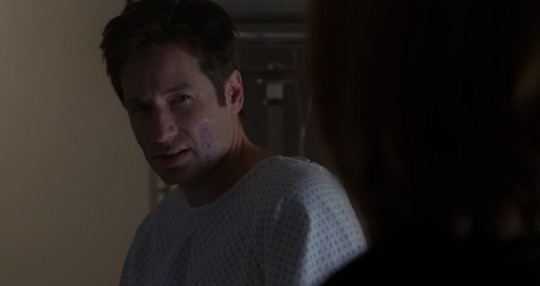
In Deadalive, Scully describes Mulder's condition as, "Blood, electrolyte imbalances, a loss of brain function. I strongly believe that Mulder is infected with an alien virus." (Another one, or the same one?) And when Mulder wakes, she tells him, "Whatever neurological disorder you were suffering from, it's no longer detectable. After a course of transfusions and antivirals it has rid your body of the virus that was invading it. The scars on your face, on your hands, on your feet, on your chest, they, they seem to be repairing themselves. Mulder, you are in perfect health."
Neither then nor later does Scully say "your brain disease from last fall is healed"-- in fact, both seem to be discussing the super soldier virus he was infected with on the ship (a sleight of hand for the writers to dodge the ramifications of the brain disease arc.) In fact, is Mulder ever told he, supposedly, had brain disease?
Mulder was taken due to "encephalitic trauma", not his brain disease (since none of the other abductees reported ill health in their spouses or missing community members.)
Mulder was infected with "an alien virus" bound and determined to turn him into a super soldier.
Mulder was returned "deadalive."
Mulder was healed by taking him off life support.
So, he was likely told about his "encephalitic trauma" and his close brush with a super soldier zombie "alien" virus... but was Mulder ever specifically told about the (alleged) year-long degenerative brain disease? The one that doesn't kill slowly, and only claimed CSM's life because of the latter man's presumptive co-current comorbidities?
I think not. Whether Mulder did or did not have brain disease, the writers seemed to want to brush that arc briskly under the rug and never acknowledge it ever again-- which is exactly what they did.
BRAIN DISEASE BELIEVERS, THERE IS STILL HOPE
Despite the ravages this meta has wrecked on the brain disease arc, there is still a perfectly reasonable-- and dare I say, logical-- explanation that would seamlessly factor in Mulder's brain disease. One could still indulge in angst alongside Season 7's original intent and Season 8's post hoc hypothetical with a guilt-free conscience.
May wonders never cease.
Except: the timeline must be drastically shortened.
THREE THEORETICAL TRUTHS
It's all come to this: three possibilities laid out before us.
Each idea works with the same conceit: Mulder was irrefutably (per the loopholes left in the writers' wake) setup by his enemies-- incongruous purchases, trips, and medical records collaboratively pulled together to blacken his name forever in the FBI-- with Scully's reputation soon to follow. The attempts ended with his burial-- which is doubly ironic, considering he rose from the dead three months later-- and the discovery of her pregnancy; but the "proof" of "their" endeavors stuck to the files like smoke.
MULDER WAS RECENTLY DIAGNOSED WITH "BRAIN DISEASE"

According to this theory,
Mulder would have had to suffer a recent relapse in order to fit in with the "cerebral inflammation" recurrence timescale.
Mulder would have had to suffer another trauma to kick off an autoimmune encephalitic malfunction.
Mulder's relapse couldn't have taken place post-Signs and Wonders or post-Brand X, since Scully would have observed the resulting tremors, mood swings, or early small-scale seizures.
Fight Club fits the aforementioned criteria and gives Mulder a free weekend to drive to his mother's and sister's graves before Je Souhaite.
Mulder would have to have been given a "to be determined" precaution rather than a full-scale diagnosis because he did not wish to be healed in Je Souhaite.
Mulder would have had to be told bad news post-Je Souhaite and pre-Requiem.
"Cerebral inflammation", as has been hammered home, is not a lengthy death: sustained damage and other comorbid factors are responsible for potentially killing the patient after the disease has been treated. As we also know, "cerebral inflammation" can reoccur via erroneous immune signals or a second traumatic event (which would kick off said erroneous immune signals.)
Mulder was in the hospital three times after Amor Fati: once in Signs and Wonders, once in Brand X, and once in Fight Club. Scully was on hand for the first two concerns, and would have seen the results of his painstaking tests and recovery. But she wouldn't have been able to witness his records in Fight Club (since she was recovering herself.) It is wholly possible that the repeated stresses Mulder's body weathered caused a relapse, one which would have been so new and so recent that it wouldn't have manifested unmistakable symptoms-- yet-- before his abduction in Bellefleur. Given autoimmune encephalitis's grace period, that gives a few weeks to three months before Scully could, theoretically, have figured things out. If that be the case, it also slots onto one of two weekends Mulder had free to travel to North Carolina (Fight Club's case wrapped up on Friday the 19th, a day before Saturday the 20th.)
Most importantly, it saves Mulder's dignity. The greatest injustice of the brain disease arc is that it implies a level of ignorance he fostered on Scully's part-- a proclivity to lie by omission rather than openly share the truth between them. While Mulder does have a history of holding back the complete truth -- his exes and past partners, his retrieval of Scully's ova during the cancer arc, his concerns about Emily's paternity, and his mutual feelings towards her-- he was more vulnerably agape after the consummation of their relationship (displaying his fear quietly in Requiem's "I can't risk losing you" plea.) And let's face it: Mulder isn't equipped for the long con-- Scully unfailingly spots and deduces his schemes or aims.
Combine these factors with Mulder's forgetfulness in Je Souhaite-- not a thought was spared towards his mortality when offered three wishes-- and it makes sense why the medical evaluation and determination interval should be kept short.
By giving Mulder a smaller window of time to process, it falls in line with his and Scully's established character traits: his need to withdraw (e.g. Conduit, Pusher, The Red and the Black, One Son, Amor Fati, etc.) before making and sharing a decision with Scully-- and her innate ability to smell out protracted brooding like a bloodhound.
(And, as formerly mentioned, Mulder never buys a headstone, regardless-- no matter how many falsified VISA cards Doggett finds.)
MULDER DID NOT KNOW HE HAD "BRAIN DISEASE"
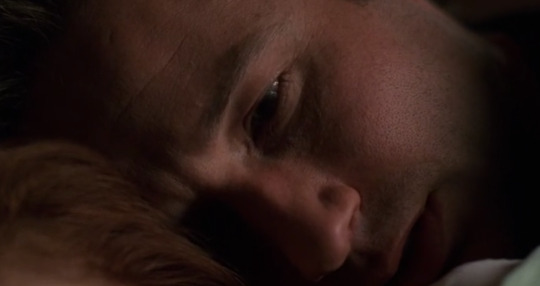
This second theory rests on the first's medical possibility, but weaves farther down a different path.
The same chronological order applies-- i.e. autoimmune encephalitis recurrence post-Fight Club.
However, Mulder is unaware of his ailing health: his doctors miss the early symptoms during their examinations; and since Scully is otherwise preoccupied (i.e. recovering), it's never notated.
Since AIEs have an additional buffer period of up to three months, and can be hard to catch without physical symptoms or a thorough MRI, it's plausible that Mulder never knew.
This would also fit with the Bellefleur abductees' "encephalitic trauma", strangely: their old injuries could have been recently triggered-- or forcefully triggered once on the UFO-- in the same manner that Mulder's injury was inflamed post-Fight Club.
This idea plays with the best of both worlds: Mulder's decay looming like a ticking time bomb over his and Scully's happiness; his and Scully's unbroken dedication to the truth and each other. A A VISA card and headstone, grave flowers and falsified reports were setup ahead of time-- orchestrated by the CSM's lingering shadow faction in allegiance with the aliens: Mulder eagerly offered as the price the overlords demand from the humans.
It also works beautifully with Season 7's intended canon (Mulder whole and hale, with no brain disease in sight) and with his and Scully's miscommunication in Three Words (he assuming she's referring to the super soldier virus, she presuming he knows she knows about his brain disease.)
MULDER DID NOT HAVE "BRAIN DISEASE"

Lastly, Mulder was not dying from brain disease:
Chris Carter and Frank Spotnitz (and the other writers) did not conceptualize Mulder's brain disease when writing Season 7.
Mulder displayed zero symptoms in Season 7 in the weeks and months leading up to its finale.
Mulder did not wish to be healed when he came face-to-face with a genie in Je Souhaite.
The brain disease timeline Agent Doggett digs up in Season 8 is built on manipulable evidence and irrevocably, triumphantly falls apart on itself.
Mulder never confirms nor denies his alleged diagnosis.
According to this theory, Mulder recovered in "Amor Fati" and did not deteriorate further. Instead, he and Scully investigated their subsequent cases with lighter hearts as they finally consolidated their relationship, found his sister, and made peace with their individual and mutual choices in life. When Mulder was hospitalized for venomous snake bites, he did not display any neurological damage. During the events of Closure and En Ami, Scully quickly ascertained that CSM was suffering and dying-- visible, physical symptoms her partner did not have. When Mulder was hospitalized, again, for an infestation of beetles in his lungs, neither his MRIs nor close, personal observation indicated that he had late-stage brain deterioration and neurological or circulatory damage. When Mulder was hospitalized a third time (alongside Scully), whatever (off-screen) complications arose then were not enough to worry him when granted three wishes an episode later.
If this be the case, the evidence "uncovered" in Within and The Gift would have been outright fabricated. This hypothesis aligns in all respects with the flimsy and superbly dissonant pieces canon offers at different times-- information only forthcoming enough to cast doubt on Mulder's and Scully's good name before disappearing immediately afterwards. Evidence, moreover, that is never corroborated between either agent, or between themselves and Agent Doggett.
It would fit with Season 8's timeline, too: perhaps Mulder makes anomalous trips in May-- with or without Scully's knowledge-- but the dates of at least half of those alleged trips clash with weekends he spent on, or preparing for, other investigations. And perhaps Mulder did investigate Squamash (doubtful): his actions there could still be divorced from an ill but hopeful man.
THE TRUE BELIEVERS
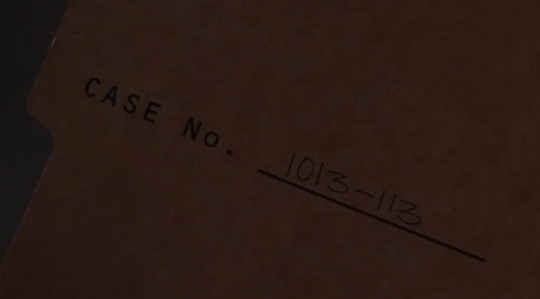
Of course, you can always headcanon Mulder did, indeed, have a year-long brain condition; but that would entail a total disregard of the facts. (Then again, when has that stopped canon before?)
FINAL VERDICT
As enlightening, entertaining, or engaging as this project has been, it will probably not shift or shape minds: whether someone believes in the brain disease or not depends on that person's emotional, observational, and intellectual tastes and pursuits.
My only hope is that this work creates or fosters a new perspective.
CONCLUSION
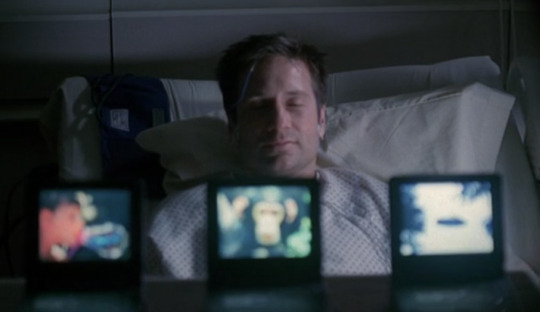
This has been my most researched and re-edited meta to date.
Thank you to @sagan-starstuff for affirming that, no, the brain disease made no sense and that, yes, I hadn't lost my mind. Hopefully the science presented tracks.
Thanks for reading~
Enjoy!
#txf#xf meta#x files#the x files#Mulder#Scully#brain disease#Doggett#In-Depth#S7#S8#mine#meta#Within#The Gift#Amor Fati#Closure#En Ami#xfiles#x-files#Mulder's Brain Disease: an Open-Minded Analytical Dissection#the biggest chonkiest researchiest meta I've done yet#thoughts
52 notes
·
View notes
Text
youtube




#david duchovny#2024#pete holmes#Youtube#awesome conversation#in-depth#so many things#he is so open#new anecdotes#he talks about his girlfriend too#and his mom#who was prompt to depression too#and the red carpet thing after his rehab#just wow#his ease to being objectified#so many thoughts#he is really opening up
64 notes
·
View notes
Text
i think we should remind musicians they can absolutely make up little stories for their songs btw. it doesn’t have to be about them at all. you can invent a guy and put him in situations to music. time honoured tradition in fact.
#sorry im bored of the same tags on this lmao#sometimes i think the confessional style loses impact because everything has to be excavated from the depths of the soul#and somehow. confessional writing seems to be going with the most disaffected bland sound possible. odd.#i love deeply personal songs! i love when songs sound like they mean something to the artist!#something something wider issue of mining trauma and being performatively vulnerable for quote unquote content#idk i don’t have the actual knowledge to write about this well there’s just something not landing for me recently#mine
65K notes
·
View notes
Text
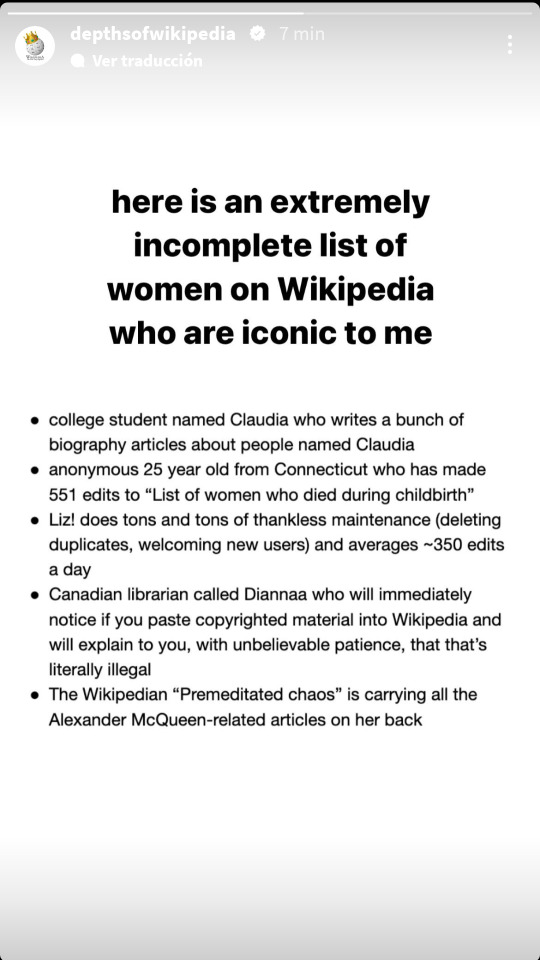
97K notes
·
View notes
Text
Code: Realize ~Guardian of Rebirth~ ❤ Game Review
We are all monsters, but still beautiful people. Code: Realize ~Guardian of Rebirth~ is a story about how low self-esteem and self-loathing doesn’t bar you from being loved, and that everyone is broken in some regard. Set in a steam-punk version of London, we get to grow with a poisonous girl as she learns about life and love from literary figures brought to life. ☆ Game Name: Code: Realize…
#english subtitles#fantasy#historical fiction#in-depth#japanese voice acting#literary characters#multiple endings#multiple LIs#otome#romance#spoiler-free#steampunk#visual novel
0 notes
Text
The Pros and Cons of Tech in the Classroom – An In-Depth Look
0 notes
Text


#dick: why are you afraid of the truth#headcanoning them as birds just feels right to me#yk Bruce was out of his depth at first the fact that he made a nest at all is very commendable in and of itself. battinson specifically#by the time damian came around he thankfully had some leaves along with the sticks as well tho dick brought the leaves#shh no one insult Bruce's omegan nest Okay#dick grayson#batfam#bruce wayne#batman#nightwing#batfamily#batman comics#batfam headcanons#batfamily headcanons#batfam shenanigans#batfam twitter#dc robin#robins#dc#dc comics#dc universe#incorrect batfam#batman smau
11K notes
·
View notes
Text
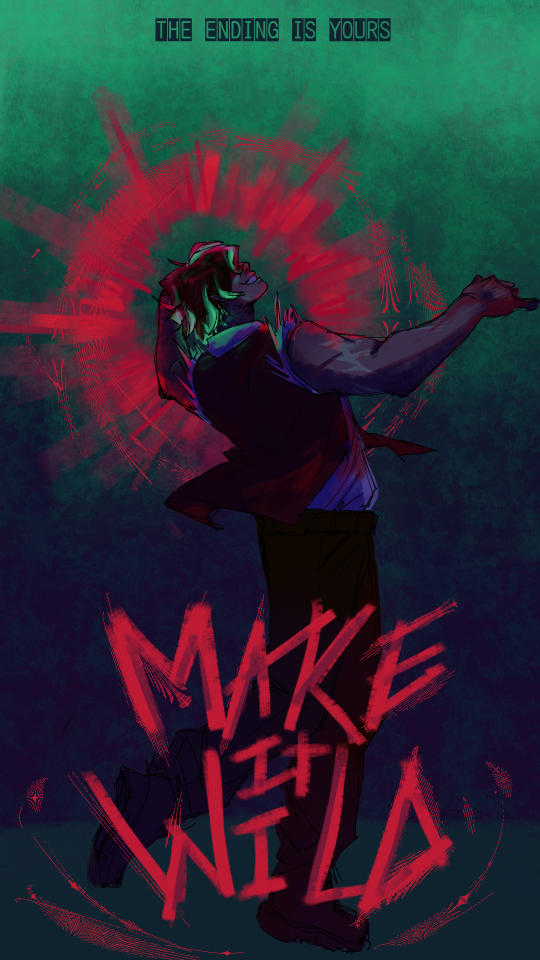
What if black hole symbolism….
Anyways go white boy go
Pose is a reference to Dabis dance in mha
#life series#joel smallishbeans#life series joel#wild life smp#wild life fanart#wild life series#wild life spoilers#wild life joel#smallishbeans#art from the depths
11K notes
·
View notes
Text
Hey, guys? Make peace with yellow teeth. I'm so serious right now.
36K notes
·
View notes
Text






Day 35– Faron Jungles
Welcome back to the depths! Zelda is beholding the wealth of botany available to her. Link is beholding nothing, because it’s too dang dark to see anything.
(This totk au is called Familiar Familiar! It all starts when Zelda doesn’t get sent back in time.)
((Wanna support me? Check out my patreon, with my throw away sketches and references! Remember to use web or android folks, apple charges 30 percent tax.))
#critdraws#lonks diary#familiar familiar au#artists on tumblr#botw#totk#breath of the wild#tears of the kingdom#lynel#the legend of zelda#legend of zelda#loz#tloz#link#zelda#totk link#totk zelda#art#faron jungles#comic#linktober 2025#silver lynel#bomb flower#faron#the depths#totk depths#loz au#jungle#istg gonna try redesigning some of the depths so it’s less uniform >:0#anyways link would lie. as a treat. just go online and tell fibs
8K notes
·
View notes
Text



lost in the waves
2024/11/07
#photography#photographers on tumblr#aesthetic#nature#nature photography#adventure#naturecore#sea#arctic#norway#senja#waves#sea waves#blue#depth#beautiful#cold#winter#fall#elements#stormy
8K notes
·
View notes
Text
My favorite flavor of Danny Phantom in the dpxdc universes is the ordinary on the first glance teenager who stands before an unimaginable, indestructible threat and throws his hands up to yell BITCH DO I LOOK LIKE I GOT TIME FOR THIS I GOT FINALS NEXT WEEK FUCK OFF and the threat retreats and crawls back where it came from
#peak badassery#danny phantom#dpxdc#dc x dp#like yeah he looks like your normal kid#but he can and will throw fists with the big bad thing from the depths of hell#the amount of fucks given: zero#cork prompts
6K notes
·
View notes
Text
The Sublime Femdom of "Little Tyrant"

Preface: This is a review post about a non-porn, largely non-femdom story that deeply appeals to me personally, in part due to its major femdom themes. But don't expect fap material! It's a Chinese xuanhuan cultivation novel that was also adapted into a webtoon. If you're still curious, please hit the jump and brace yourself for an enthusiastic wall of text, sprinkled with beautiful art to try to help retain your attention.
Introduction I: A Dream of Mine
You can find countless varieties of fictional femdom these days. For example, there's drawn/rendered femdom porn in the form of comics/CG sets/games/still art, which is the main subject of this blog, i.e. "2D femdom". There's erotic literature, and voice dramas. There's a subset of photographic femdom porn that constitutes fiction. On top of that, a lot of fictional femdom eroticism is not porn: it's mass-marketed and often high-budget. Like scenes in Hollywood movies or music videos that involve sadistic women. Or anime with kinky dommes, often thrown in for comic relief.
All of us have different fictional/idealistic preferences and cognitive predispositions, which influence which mediums we take an interest in, and how we like to see our femdom fetishism represented in them.
Let me tell you about one of my dreams. For a while now, I've wanted to see a story with a plot that's genuinely interesting, and enjoyable in its own right… but with a protagonist who's unapologetically submissive, and a heroine who's dominant and for whom that dominance is respected and embraced within the work itself, who are romantically requited. That's right, I want a good piece of fiction to depict a satisfying femdom romance while also not having a romance focus. The femdom should be a feature, not a crutch to attract a niche to read a story they otherwise wouldn't.
We've at least moved past the old era where major 2D franchises' fictional characters could never have legitimized D/s kinks. For example, there's Darkness from KonoSuba or even better Tio from Arifureta. But those two are still far from my ideal, not least because they're cases of maledom rather than femdom. And editorial censorship is still rampant; such openly sadomasochistic lead characters could only be born because both of those series started as web novels, a medium which pushes the boundaries of acceptable expression.
Introduction II: The Core Premises are Regression and Cultivation
Now then, the subject of this article is a web novel called Little Tyrant Doesn't Want to Meet with a Bad End (Chinese name: 恶役少爷不想要破灭结局), authored by Bells on Cat Ears (猫耳铃铛).
Little Tyrant, which I'll call LTBE from now on, is a medieval fantasy web novel in which magic and even deities exist. The male lead is a 10-year-old boy named Roel Ascart who lives in a medieval fantasy world, and suddenly awakens to memories of his past life: he was a college student from our world, and in our world he played a ren'ai game called Eyes of the Chronicler… and bizarrely, this world is the very world of that game. Based on Roel's knowledge of the game's plot, he knows that the side character Roel who he's currently reincarnated as is a mean-spirited brat of a noble family which loses everything; after that, he joins an evil cult, and years later is justifiably murdered by the game's heroines. Roel doesn't understand why he's in this odd situation, but the memories of the "game" match up to this world, so he fears for his life. Thus, he desperately tries to proactively change his fate, which means acting differently toward others and taking his life more seriously.
Over the course of the full 670-chapter, more than 1 million-word epic novel that spans many years, he succeeds beyond his expectations, though he encounters almost equal adversity. He tries to make the heroines he fears "not hate" him (result: they fall in love with him, and vice-versa!), and become "strong enough to survive on his own" (result: he becomes badass!). This much isn't a spoiler; the fact that LTBE is a harem romance and has a conditionally overpowered protagonist are core selling points for this kind of web novel. The real pleasure is seeing how everything plays out. The story is quite complex and dramatic at times, with constant near-death experiences for Roel.

LBTE is both a regression novel and a cultivation novel. I'm not sure if you, reader, have read many regression novels or cultivation novels before. Cultivation refers to a power level trope in which strength is divided into "realms", higher realms are reached through diligent and methodical strategy, breakthroughs often require one to risk their life, and the strongest people have lengthy lifespans and god-like powers. Regression refers to a story about a person who time leaps to the past to redo their (or someone else's) life and fix mistakes. (You may recognize this specific kind of regression plot from "villainess" anime like Hamefura or 7th Time Loop; the regression of a spoiled young noble is a popular premise.) Whether you will like LBTE ultimately mostly depends on whether you will like either or both of these novel genres. The femdom is far from the core appeal. If you try it read LBTE just for the femdom and don't like the rest of it, you probably won't make it very far in!
Now that I'm about to talk about the femdom, let me make this completely clear. As I stated in my preface, this novel is not femdom BDSM porn. There's no pegging or chastity cages. There's no 24/7 D/s relationships or even outright submission. You shouldn't have excessively high expectations. However, LBTE still has what I consider the most unapologetic femdom dynamic of any mainstream story I've ever read. And the story is actually good on top of that (if you like this kind of novel)! That's why I praise it as "sublime" in the title of this post.
Dominant and Controlling Heroines, and a Submissive Hero
LBTE is a little different from a typical power fantasy. It's not a story where the male lead is OP and the heroines are his sycophants.
The physical dynamic: For one, all four of the heroines are significantly stronger than Roel in a conventional context. Technically, if Roel is in perfect form and goes all-out and unleashes his trump cards in a battle to the death, he's stronger than the heroines. However, that kind of heroic scenario that makes Roel looks cool only happens at climactic moments. For the vast majority of the story, Roel either is forced to hide his power, he can't tap into it, or most often of all, he's in a severely weakened state as a result of his power's backlash. The four heroines, on the other hand, are absolute geniuses who possess combat ability that won't lose to anyone their age. They also wield greater wealth and/or influence than Roel. That means that for the entire novel, the heroines are almost always free to physically do whatever they want with Roel, and it's difficult for him to physically resist them. He often has to negotiate, or play on their emotions (they do that to him more than he does it to them, though!) if he wants to evade their advances.

The personality dynamic: Roel is a massive tsundere. He has a lot to worry about, and many secrets. Therefore, he tries to keep his distance from the heroines, aided by his sharp tongue and self-confident demeanor, despite how much he cares about them. However, they don't let him. They quickly realize he's all bark and no bite. He can't bring himself to ever say a mean word to them, and rarely ever pushes them away when they start to be intimate with him, unless it's in public and they refuse to let go of him quickly. They frequently play on his emotions, and he's even described as "weak to their tears". The heroines also often flirt with him forwardly in ways that make him actually blush. The novel isn't subtle about this dynamic, either. The narrative states that "the Ascarts' men seemed to have an inclination toward dominant women" in chapter 328, and "in view of the Ascarts’ odd preference for dominant women, Nora and Charlotte had paid particular attention to Lilian ever since enrollment" in chapter 332.

Yes, he's whipped, he's the bottom rung in this novel's love polygon, and I love it. That's just the kind of femdom hero I idealize: someone who doesn't have a subconscious insecurity about the fact that the girl they love is strong and assertive, and thus doesn't try to suppress her dominant demeanor, but instead plays the perfect counterpart to it, legitimizing and affirming it. There are many male leads in other stories who, when faced with a domineering heroine, will suddenly act in a way that sweeps her off her feet, and causes her sadistic smile to transform into a maidenly blush, as if her dominance was just a bluff or thin pretense to cover her true personality. I assure you, LBTE is not like that.
From here on, I'll talk about the heroines in detail, and you should expect SPOILERS. If you want to try this novel yourself first, I recommend that you skip down to the section "Where To Read It" instead.
Nora Xeclyde, the Sadistic Saintess

Nora Xecylde, the princess and future pope of the Saint Mesit Theocracy, is by far the most dominant heroine in LBTE, and also the only one of the four heroines explicitly called "sadistic" in the narrative. She experiences joy from abusing and trampling on others. In the original timeline that only Roel knows, she had to hide her true self for the sake of political stability, but she unleashed these cruel tendencies in combat as a way to relieve stress, which led to her being famous as the "Bloodthirsty Angel" who torturously butchered her enemies on the battlefield. That history changes when she meets Roel, the son of a noble who's part of her father's political faction, and she quickly discovers that is somehow aware of her true personality that she'd tried to hide. After realizing that he's someone who can keep a secret, she relishes the chance to toy with him and express her unusual desires; she's amused by him, especially his fear of her. Her sadism is also how she expresses her love, and over the course of the story, the more she truly cares for him, the more bullying him truly grants her happiness.
Nora's character is quite deep, and she's by far the best "femdom heroine" in LBTE. My brief summaries here won't do justice to all of a lengthy development she receives; you'll need to read the novel itself for that. Over the course of the story, Roel frequently complains about how perverted she is and expresses aversion to being the subject to her sadism, but from the start he acknowledges and accepts it completely. In one occasion where she expresses self-doubt about how her perversions make it hard for him to have a relationship with her, he vehemently corrects her and tells she shouldn't change, that her nobility, spirit of self-sacrifice, kindness, and sadism are all irreplaceable parts of who she is. She frequently talks as if he is already her property, or says that she wishes he would lie down and let her step on him, tie him up, and so on. On special occasions when he wants to make her happy, he'll even proactively cooperate with her wishes. Of course, her magically cultivated physique is superior to his, so he can't physically resist her anyway.

Early on, Roel and Nora meet Victoria Xecylde and Ponte Ascarte, distant relatives of their respective families who are also in a romantic relationship. What's incredible is that those two also have a somewhat femdom dynamic, and the story deeply emphasizes this. Ponte's powers actually have a ritualistic penalty which requires him to keep journals of his embarrassing thoughts, show them to at least one other person, and make sure they are never destroyed. Since he's Victoria's bodyguard, he ends up having to show her his journals in which he fawns over how cute she is and writes other fetishistic thoughts about her… despite being technically a married man (purely political and loveless; they haven't seen each other for many years). Victoria uses this as blackmail material to keep him under her thumb, and constantly teases him; she's also attracted to him, and tries to persuade him to elope with her (and eventually they do!). One pair of sentences I particularly like: "The two princesses of the Xeclydes displayed their dominant personalities, leaving the two subdued Ascart boys looking at one another. They suddenly realized just how low of a standing they seemed to have before these two women." And take a look at this humorous excerpt:
Roel didn’t just look at their interactions but the atmosphere around them and the subtle gestures they made too. While Victoria had hidden it well, from time to time, she would still exude a certain disposition that he was deeply familiar with. He shot a glance toward the well brought up Nora, and he suddenly understood where her sadistic tendencies had originated from. It’s a hereditary trait that shows up once every few generations, huh? Perhaps it was because she had sensed Roel’s thoughts, but Nora suddenly turned her head over and stared at him. Under her intent gaze, he quickly averted his eyes, only to be met with Ponte’s gaze right after. The two boys of the Ascart House exchanged looks, and they suddenly felt a sense of camaraderie with one another. It was a feeling of deep connection created by mutual sympathy for one another, due to suffering through the same plight. They were like oppressed peasants ready to raise up in arms against the Xeclyde girls… … though it was not as if they would really dare to do so. Their rebellion would probably just be quelled in an instant.
Most of all, I love the way Roel and Nora's relationship evolves after her second major character arc, a life-and-death crisis which is the most memorable arc to me. I'll hold back on details, but in that arc, he crafts a special magical tool for her, one which saves her from despair and also reaffirms the deep connection between the two of them. However, after the arc is over, it becomes clear that Nora now has full mastery of that tool, and can unexpectedly use it to control and dominate Roel. It's romantic and endearing how he finds himself unwilling to complain at having it used on him after she reminds him of the circumstances of the gift.
Perhaps to counterbalance her sadism, Nora is actually the main heroine who treats Roel with the most respect. She's the only one of the four who never outright kidnaps him.
Alicia Ascart, the Clingy Stepsister

Alicia is adopted by Roel's father shortly before the story of LBTE begins, and is a pretty but otherwise seemingly ordinary girl two years younger than her new stepbrother. However, Roel knows from the plot of the game Eyes of the Chronicler that Alicia is actually incredibly talented as a transcendent (magic user), and would become a church-affiliated assassin after the "side character" Roel Ascart mistreats her. And so, he's determined to make sure he treats her well in this life. But Roel accidentally dotes on his sister so hard that she falls obsessively in love with him. After that, she becomes a master schemer, and pretends to be a meek, innocent, and gentle little sister so that he will completely let down his guard around her.

I'll take this opportunity to provide an important disclaimer: if you're the kind of person who applies real-world psychological models to the behavior of regressors toward other young non-regressors and often finds it problematic, you may want to stay away from LBTE. Furthermore, if you don't like the idea of a young girl who isn't even double digits yet lusting after her brother who's barely older than her, you may want to stay away too! Yes, this novel is like that at times. Of course, she's just a kid, so there's no actual sexual acts or explicit descriptions, just, uh, a very physical obsession with him. She's seriously a horny kid. The webtoon adaptation (more on that later) actually chooses to turn a 1-year time skip into a 3-year time skip, and gives the heroines very full figures, and I think Alicia might be half the reason why. But anyway, back to the subject of femdom.
Alicia not only keeps her affections a secret from Roel, so when she's physically intimate with him, he believes that she's just overly attached to her brother. And she keeps her power level a secret too, so that when she casts spells to send him into a deep sleep to stop his resistance when she sneaks into his bed at night, he doesn't suspect that she's the reason for his suddenly sleepiness. At one point, she does this when they're on a road trip, but screws up, so Roel's guards mistake her for a succubus-like monster and almost attack her. In any case, while he's in a magic-induced sleep, she will often kiss him a lot, and her behaviors both in the day and in the night are specifically designed by her to try to make him emotionally dependent on her and unable to live without her or unable to do what would make her unhappy. Later on in the novel, she uses her power as a kind of magical aphrodisiac, and she eventually secretly employs actual aphrodisiacs (just once, though; Roel does NOT appreciate this, and makes that clear). At one point, Alicia gives romantic advice to another woman and reveals a bit too much of her character in the process:
“When it comes to quickly advancing a relationship, the best way is still to rely on drugs.” “Ah? Drugs?” Chris was horrified to hear a potential criminal plan coming from a young woman's mouth. What further frightened her was how naturally Alicia mentioned it, as if it was perfectly normal. “That's right. Lord Brother is a smart person, but he's innocent when it comes to relationships. As long as I can 'secure' him, it would be my victory.” “No, I mean, won't most people get angry at something like that?” “Of course. Lord Brother would definitely get angry, but I'm not afraid. I just have to burst into tears, and that would soften his heart right away.” This woman is terrifying!

All of the Ascart family's servants (mostly maids) are Alicia's allies, who secretly support her in her efforts to advance her relationship with her brother; the plan is to eventually have her father un-adopt her, and then re-marry into the Ascart house formally, which would be societally acceptable. Her Origin Attribute that forms the basis of her transcendent powers is Perfection, which means that she grows in power the more she engages in efforts to be what she considers 'perfect'. And she chooses to be the 'perfect younger sister' and the 'perfect wife'. Alicia's personality is very yandere-ish, as she was the first heroine to meet him and wants to monopolize him; she's sweet to him, but cold and ruthless to those she views as her enemies. Well, later on in the novel, there's a major shake-up related to the secret of her bloodline, which leads her into brief dramatic confrontation with Roel, so it's not as if that coldness is never directed at him, either.
Charlotte Sorofya, the Merchant Heiress

The first scene with Charlotte introduces her as a high status young lady who uses her divination abilities to declare that a businessman associated with her family had become involved in gambling, and cut him off financially. Her ability to see through things and her calm personality and leadership abilities appear intimidating at first. That said, it's soon revealed that her racist mother abandoned her because Charlotte has some elven blood, and she yearns to have a family that truly loves her. Her Loyalty Origin Attribute also causes her to be unable to betray whoever she falls in love with, so she's clearly heroine material. In fact, for the most part, she's the least dominant of the four heroines. She never purposefully humiliates him like Nora, and never helps herself to his body while he can't resist like Alicia.

However, it's exactly because she is so sincere that she can without hesitation commit crimes to try to requite her love for Roel. And her gentle demeanor just makes it scarier. Charlotte's first character arc and second character arc happen one after the other… because she falls in love with him in her first arc, and kidnaps him in her second arc! This is still probably the second most memorable arc of the entire novel to me. She "stealth kidnaps" him such that he himself doesn't realize that he has been kidnapped even weeks later, coming up with various excuses and lies that let her take him further and further away from his home. When he's finally about to realize the truth of his situation, she suddenly asks him in a very meek way if he will forgive her if she does something wrong, and when he reluctantly says that he will, the next moment, she knocks him unconscious! And when he next wakes up, he finds himself in her bed in the neighboring nation. What's unique is that while she does all this out of a determination to marry him (well, she's also afraid that she'll be separated from him and thus unable to continue to provide him with critical medical treatment), she's still afraid of him hating her, so she comes up with all kinds of ways to ply him, which includes bribes. As the future leader of a nation ruled by merchants, her personal wealth in unimaginable, and she doesn't hesitate to offer to pay Roel for his forgiveness, and since he's desperate for money for various reasons, he always accepts. Roel is also familiar with the characteristics of her Origin Attribute and knows that she will always love him, so as the person who caused her to fall in love, he also feels some responsibility for her extreme behavior.

At the start of Charlotte's first arc, Alicia actually schemes with Nora and the Ascart family servants to frame Roel as a cruel womanizer, all to make Charlotte lose interest in him. For a while, they actually succeed, and the result is that for a period of time Charlotte looks at Roel, as well as speaks to him, like he is human trash. Her behavior honestly felt like femdom fanservice to me… I've actually fantasized about this kind of plot device, where a character is framed and it causes a heroine who could've loved him to despise him instead, in a femdom context many times. Also, while Charlotte is for the most part hands-off and gentle, she's not above teasing Roel either:
“How do you intend to measure me without using a measuring tape?” asked Roel in confusion. There was a gleam in Charlotte's eyes as she raised her hand and waved it about. “I'll be using this.” Under the dim lighting of the Dancing Butterfly Manor, a faint blush could be seen forming on Charlotte's beautiful face. She softly placed her dainty hands on Roel's chest and used her fingers to measure the breadth of Roel's chest. Roel felt awkward at the situation. The two of them were so close that all it took was a step forward to embrace her soft body. He could feel Charlotte's warm breath tickling his neck, and it sent a shudder to run through his body. “Ah. Did I tickle you by accident?” asked Charlotte. “No, it's fine.” Roel turned his head away and refuted her question. Charlotte stared at him intently for a while when realization suddenly struck her. Her lips curled upward. Instead of taking a step back, she took another step forward. “Is that so? I'll continue then,” said Charlotte with a teasing note to her voice. She placed her finger on Roel's chest once more and resumed her measurement of his chest, but her focus wasn't on the measurement this time around. She kept fidgeting during her measurement, causing her body to constantly lean in and bump into Roel's. … On the other hand, Charlotte was getting more and more absorbed in her teasing, especially when she noticed the gradual reddening of Roel's cheeks. It took her all she had to hold back her laughter, but it still didn't take long for him to catch onto her prank.
But for the most part, Charlotte does not express much dominance compared to the other heroines.
Lilian Ackermann, the Cool Senior

There's no doubt that Lilian is an imperious and authoritative character. After all, she's been in ruthless competition with her brothers for the imperial throne since she was a child. She doesn't have anyone she can trust. Overall, she's incredibly smart, powerful, and competent, and Roel is a noble a nation which is her empire's chief rival, so from the start of their relationship as fellow students, she takes pains to not be friendly with her junior Roel. That said, she and Roel eventually discover a certain mysterious connection that leads them to trust each another, but you'll have to read the novel itself if you want more details on that.
However, what truly amazes me about Lilian is her second arc and its massive oneshota energy. (This is another one of those arcs where my above disclaimer about people sensitive to "problematic" content in fantasy stories applies! Then again, if you can't tolerate lowkey oneshota you probably can't tolerate half of Japanese femdom, so you're probably? not a reader of this blog...) Simply put, Roel is magically transformed into a little kid as a side effect of his powers. This not only makes him physically smaller and weaker, it somehow makes him more emotionally unstable. Oh, and his clothes don't fit him anymore, so Lilian initially offers him a used towel that smells like her to wrap around his waist. Meanwhile, another character advises and tempts Lilian (who has just fallen in love with Roel) to try to take advantage of this situation to cement her relationship with him.

Yep, that's correct, this whole arc is about the heroine scheming to seduce a pseudo-shota. I'm not even exaggerating at all; the prose is outright psychoerotic:
Looking at the adorable little creature in her arms made Lilian feel like an arrow had shot right into [her] heart. Her breathing that had remained stable even as she scaled across mountains turned erratic, and her body started to heat up. … How would he taste like [referencing a deep kiss] in his current form? … Lilian stared at the person on the bed as her breathing hastened. She placed her trembling hands on his oversized clothes, knowing that she could remove it all with just a simple tug. Words couldn't begin to describe how attractive that notion was to her, but she felt like she would completely lose control if she gave in to her desires.
The issue here was that Roel had retained his hypersensitivity to mana as an Origin Level 4 transcendent despite losing his powers, resulting in the suppression he felt from Lilian being abnormally powerful. Naturally, the instinctive fear he felt toward her was much stronger too. So, Lilian changed her strategy right away. She first reined in her mana that had gotten lively due to her agitated emotions before slowly approaching the boy with steady footsteps. She tried to make her expression look as gentle and friendly as possible so as to not appear threatening. On the other hand, Roel was feeling greatly panicked and confused. His logical mind told him that the person before him was Lilian, someone whom he could trust, but for some reason, there was a pang of fear in his heart that identified her as a menacing threat that he mustn’t get close to. It was like the innate fear a peasant felt when standing before the emperor, a sense of inferiority toward a higher life form. It was so oppressive that he dared not to even look into Lilian’s eyes. Even when he felt the bed undulating from her climbing onto it and crawling over to his side, his eyes still remained firmly lowered, not daring to raise them in the least. On the bed, Lilian was crawling up to where Roel was, but the latter was still looking downward with a reddened face. Roel was feeling conflicted at the moment. On one hand, his innate fear was prompting him to stay away from Lilian, but on the other hand, he was enchanted by the gorgeous woman before him. These two intense feelings pricked at his nerves. Terrifying… but beautiful. I want to get close to her.
The solemn vow made Roel raise his head and look at her with widened eyes. This was the first time he was looking straight at her since the regression of his body. He found himself met with a pair of clear amethyst eyes that were tender and determined. They gleamed brightly as if there were stars in them, and the only thing reflected in them was him. The woman who stood firmly behind a towering fortress to protect him from the dangers beyond surfaced in his mind, and slowly, the fear he felt from the suppression of Origin Levels disappeared. In its place came a flood of shame. He felt awful for fearing someone who was willing to put her life on the line for him. Lilian noticed Roel’s self-reproach, but she didn’t say a word at all. She simply opened her arms wide with a smile, her action far surpassing the significance of any words. “I’m sorry, senior,” murmured Roel hoarsely. The two of them embraced one another right after. Roel was unable to reach Lilian’s shoulder due to his miniaturized physique, resulting in him being buried into Lilian’s breasts across the towel. He was uncomfortable with this, but at the same time, a mixture of gratitude and affection made him reluctant to part from her… not to mention that he was indeed unable to move at all. Lilian’s arm was holding his waist firmly, causing their bodies to be pressed together. He could hear her hastened heartbeat loud and clear. Bloodline resonance, despite being weakened, naturally occurred between the two of them. Time ticked by, and their bodies began flushing red.

That other character I mentioned, a mysterious ally with a seductive personality, tells Lilan that if she doesn't make Roel hers consensually, Lilian's inner darkness will compel her to forcefully make him hers later, and describes this doomsday scenario: "He will try to stop you, but can't. He'll be ruined by soft-heartedness in the end. He can't bring himself to kill you, and you will exploit his weakness to defeat him. By then, that twisted love of yours will compel you to murder all of the women by his side. What else will you do once your obsession for him runs amok? I reckon that imprisoning him is only the appetizer…" And crazily enough, Lilian knows in her heart that what the other character tells her is true: "Indeed, she was shaken not because of the terrifying prediction but by the realization that she actually felt a hint of anticipation for it. The feeling wasn't strong, but it proved that such dark thoughts did exist in the recesses of her mind."

Over the course of this arc, she also dresses up as a maid and Roel dresses like nobility, so they disguises themselves as a young master and his caretaker. Note that the novel specifically mentions that the maid outfit is very conservative, not at all like the maid cosplay Roel recalled from his previous life's memories, yet in the webtoon adaptation, they ditch that and just dress her in a sexy maid outfit. Hooray for non-faithful adaptations?
That's it for my overview of the main heroines' femdom elements, and I think I covered many of their best femdom moments. Let me just close by making two further points for the record. First, there's still a lot more femdom that I just didn't take the time to describe, so look forward to it. And second, don't forget that this is above all an epic action story with a genuinely rich setting, and a badass male lead; I just made him look pathetic because I highlighted all the moments where he's at his most vulnerable, which is in front of the heroines. But he seriously is a badass; just look at this Stand of his.
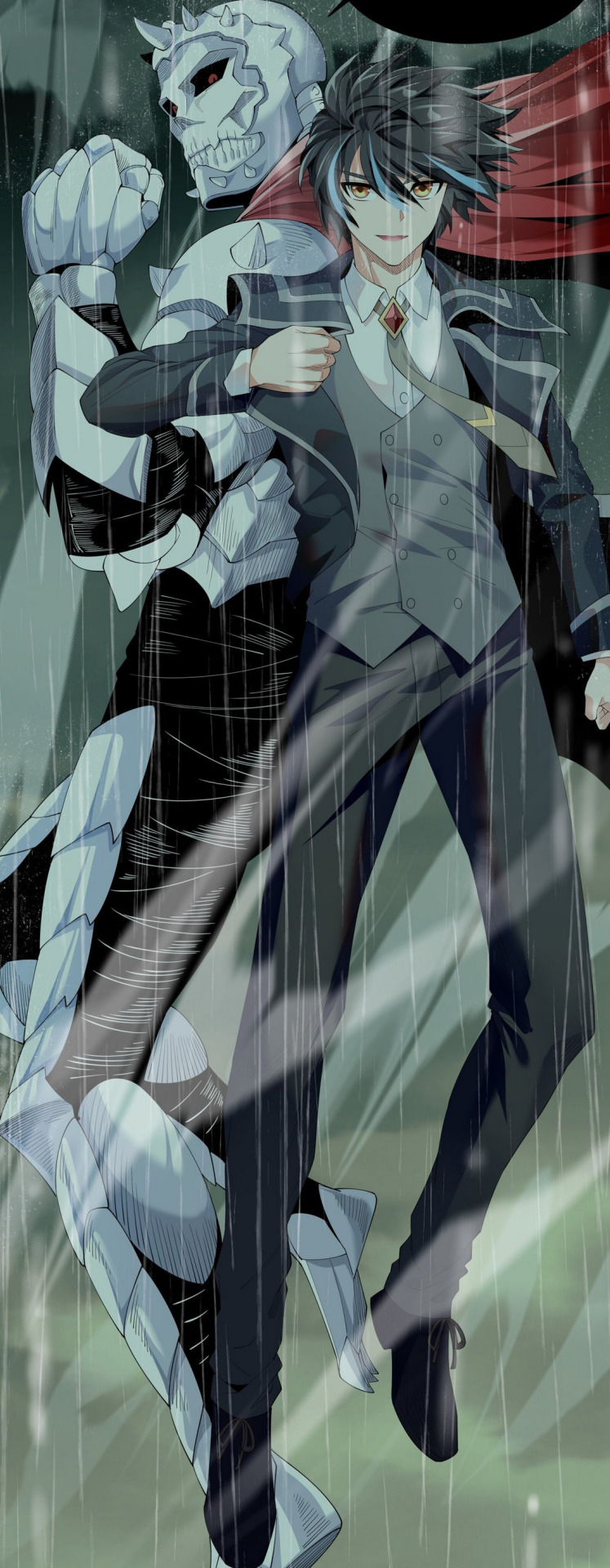
Where to Read It
You're in luck! The entire Chinese web novel has been licensed and officially translated by the website Hostednovel, and is available to read for free on their ad-supported website. That said, if you're so inclined, you may want to buy the cheap ebooks on Amazon which cover I believe ~70 and ~90 chapters each, around the first quarter of the entire epic, since those have been further edited. This TL project, which started exactly 4 years ago and finished around 7 months ago, has been a major labor of love by the prolific and experienced translator StarveCleric and their editors, even running a fan art contest. The Fandom wiki is also highly detailed.

As for the webtoon, that's a little more complicated. The original Chinese version of it was recently completed with 97+1 chapters total. ZeroScans fan scanlated to English 36 chapters of it, and it was licensed and officially scanlated by the international version of Bilibili Comics under the name "Evil Young Master Doesn't Want a Bad Ending" and scanlated there up to I believe chapter 59, but then the entire site shut down so it's not available anymore legally. Then as far as I can tell, the website Manuafast did a low quality scanlation of the rest of the chapters. So the only way to read it is to, for example, read the first 36 chapters on MangaDex and the finish the rest on a site like Manhuafast which pirates official scans to fill the gaps. Furthermore, the webtoon abruptly cut the story short, i.e it was axed: 95 webtoon chapters cover around 400 of the 670 novel chapters, then from the very start of webtoon chapter 96 it abruptly time skips and summarizes major future events, lore dumps, and adapts the last few novel chapters. Whatever you do, don't read past chapter 95 of the webtoon before you've read the full novel. Furthermore, the webtoon itself, while pretty to look at it, doesn't adapt all the details of the story, so I personally suggest you only use the webtoon as a way to check whether you like the style of LBTE's story, before you switch to the novel.
Final Thoughts
At the beginning, I wrote about a dream of mine. So, does LBTE realize that dream? Honestly, not quite. While LBTE is indeed a good piece of fiction that doesn't have a femdom focus, and it's also mainstream to the point that it received a webtoon adaptation and localization, it doesn't quite reach my ideal for a "satisfying femdom romance". Close, though. The reason is that Roel, while being a bit submissive, isn't submissive enough to completely receive Nora's sadism. She's constantly holding herself back for his sake.
I think the fundamental difficulty in seeing this "dream" realized is that the more explicit a story's BDSM, the more that story is likely to narrow in on the romance and take time to justify it and contextualize it. Nana to Kaoru (maledom) is like that. Many josei demographic femdom romance manga similarly try to characterize BDSM as a metaphor for trust, to try to make it seem less crazed to the vanilla. And in Arifureta (again, maledom), there's one arc where Hajime, a semi-closet sadist, and Tio, a brazen masochist, are mysteriously transported to another world by themselves, and they take advantage of the situation where no one knows them, to have Hajime fit her with a dragon-sized ballgag and whip her while riding her around in her dragon form; that incredible scene could only happen because they effectively left the main story behind and went off on a honeymoon, so there are no spectators. From easiest to hardest to see in a mainstream franchise, I think it's ranked like this: openly masochistic heroine < openly sadistic heroine < openly sadistic male lead < openly masochistic male lead. In particular, an openly masochistic male lead is a very hard sell to a lot of people; the #1 complaint I saw from English-speaking fans about LBTE is that the male lead let the heroines push him around too much. Still, I continue to dream. Similar to how IMO gay romances are best when they ditch the overly self-conscious drama and secrecy and just have side characters be casually supportive, one day I hope to see some femdom relationships where side characters are aware of it, understand it, and respect it. Web novels, and perhaps even web manga, will probably lead the way.
When I first read LBTE, I was so surprised and happy with what I found that I decided I had to post about it. And so, here we are. As I wrote at the very start: LBTE isn't a story every femdom fan will enjoy, because it's not outright erotica. But I hope this review has at least helped you appreciate its existence.
Side Talk
I first read this story back in April-May, and took extensive notes and screenshots as I read it to prepare for this post. And now, it's finally done… like I said before, I have many ideas for other posts. The next one I come up with will definitely be smaller in scale and not involve as much research. Lately, I've been playing a lot of Japanese femdom RPGs, so maybe I'll talk about those.
This year, the credit card duopoly has also been contacting various Japanese web platforms that sell 2D adult content one after another, 90% of those platforms not making any changes and losing access to the VISA/Mastercard systems, which now makes it harder sometimes for foreign users (as well as domestic Japanese users, if the alternatives are inconvenient to them) to buy from them. Of course, this affects femdom content. It's an unfortunate trend, but the steadfast resistance of many business has been reassuring. I probably won't bother to post a sequel to my post about femdom censorship, in part because I feel that excessive English language attention to this controversy can only worsen the situation, so I'll just sum up here what's happened. Getchu is the only company that seemingly outright folded to these companies and deleted industry content (old hypnosis fetish games). DLsite, which also runs Ci-en, changed their tags (in a sadly clownish way that I think was counterproductive) hoping to appease the duopoly, it wasn't enough anyway for the duopoly and they were forced to cut ties, but the tag names are still altered. Pixiv didn't change much; the status quo is mostly what I described in my previous post, except automated scanning of text inside images has now led some Fanbox users to preemptively censor some sensitive terms with the 〇 character. Other notable companies targeted include Fanza/DMM, Niconico (yes, the video site), Skeb, and Toranoana. And many more have been targeted but just received less attention, or people don't know about it. However, a few days ago, Yamada Tarou and Akamatsu Ken met with the VP of VISA in Japan and put pressure on them, which apparently could result in a reversal of this trend. As usual, it's hard to know the full story of what's happening behind the scenes, but if you ask me for my personal opinion, I'm not worried that the 2D femdom is any serious danger, because Japanese companies have collectively taken an anti-censorship stance, the Japanese public also vehemently criticizes this censorship, and most sales are domestic plus the Japanese have other payment methods to fall back on which lessens the financial impact on companies. Sites like Fanbox continue to support a larger variety of innovative femdom creators than ever before. In my highly amateur opinion, the only thing that I think could threaten this status quo would be if there's a significant domestic legal or political pressure which forces the major companies to switch their stance as a whole, or over the long term increased foreign investment results in greater foreign influence on the anime industry as a whole which results in a shift in norms.
All right, that's it from me; have a nice day.
0 notes



